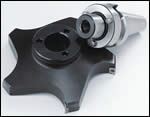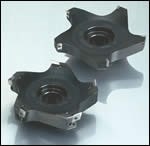Bigger Cutters For Small Mills
This cutting tool manufacturer has developed a lighter, more compact face milling cutter that is available in 80-mm, 100-mm and 125-mm diameters for 30-taper machines.
Share




Until recently, shops performing face milling operations on small vertical machining centers with 30-taper spindles were limited to relatively small (up to 80-mm diameter) milling cutters, which limited the machines’ metal removal rates. Using a larger-diameter cutter to achieve a greater metal removal rate usually meant moving up to a larger machine that could handle the tool’s greater size (length as well as diameter) and weight.
Now, however, a cutting tool manufacturer has developed a lighter, more compact face milling cutter that is available in 80-mm, 100-mm and 125-mm diameters for 30-taper machines. The larger-diameter cutter was designed to provide higher metal removal rates in the machining of aluminum and cast iron than has been possible with more conventionally designed, smaller-diameter cutters. The cutter, called the Exocarb Disc Cutter and made by OSG Tap & Die, Inc. (Glendale Heights, Illinois), comes in an S version for roughing and finishing operations and a Pro version exclusively for finishing operations. The S version is equipped with carbide inserts and is not adjustable; the Pro version comes with PCD inserts that are adjustable over a 0.100 range, allowing the user to maintain fine surface finish from part to part.
Features of the new cutter that distinguish it from conventional 30-taper cutters are a slender, lightweight, star-shaped steel body and a more compact method of joining the cutter body to the arbor that uses three pins instead of the usual keyed assembly (see photo). The 125-mm diameter, S-version cutter body weighs 2.2 pounds, compared to as much as 7.5 pounds for the more massive conventional cutter body of the same diameter. Thanks to its design, the new cutter body is even a bit lighter than a 125-mm diameter aluminum cutter body and sells for about one-third of the cost.
Replacing the standard key-and-keyway method of locking the cutter body to the arbor enabled the manufacturer to reduce the gage length of the tool (the distance from the point where the tool contacts the spindle to the cutting edges of the tool) from 45 mm to 29 mm. That not only reduced the amount of metal in the holder, permitting the total weight of the tool to be held to about 3.5 pounds, but it also increased the rigidity of the tool because of the reduced overhang.
The 125-mm diameter cutter was tested on a Brother CNC machining center with a BT30 spindle machining 7075 aluminum. Using a feed rate of 160 ipm and a spindle speed of 8,000 rpm, the tool achieved a metal removal rate of more than 73 cubic inches per minute. The (star-shaped) tool is designed with only five inserts versus eight for more conventional face milling cutters. However, the manufacturer stresses that the cutter’s metal removal rate is greater that that of a smaller-diameter conventional tool, which is the only other option for the 30-taper machine.
Obviously, the big advantage of the 125-mm cutter is that the user can machine more of the workpiece surface in one pass on the smaller machine, achieving greater productivity than possible with a smaller-diameter cutter. Also, the user may be able to get by with a single pass, eliminating one or more plane lines that usually result from parallel cuts. Another plus is that use of the lighter, more compact cutter in place of the more massive conventional cutter should reduce wear and tear on the machine tool’s spindle bearings.
OSG observes that, instead of downsizing, a lot of companies are shifting to more efficient setups and smaller, more efficient machines. They want to minimize their initial machine tool investment, save floor space and save energy, all of which points to smaller machine tools. However, they are also looking to maintain high productivity, and the new cutter will help shops get that productivity from the smaller machines.
Read Next
5 Rules of Thumb for Buying CNC Machine Tools
Use these tips to carefully plan your machine tool purchases and to avoid regretting your decision later.
Read MoreSetting Up the Building Blocks for a Digital Factory
Woodward Inc. spent over a year developing an API to connect machines to its digital factory. Caron Engineering’s MiConnect has cut most of this process while also granting the shop greater access to machine information.
Read MoreRegistration Now Open for the Precision Machining Technology Show (PMTS) 2025
The precision machining industry’s premier event returns to Cleveland, OH, April 1-3.
Read More




























.jpg;maxWidth=300;quality=90)



